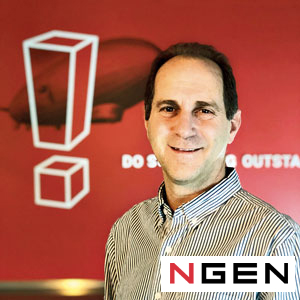By Natasha Rombough, Director of Marketing & Communications, CHBA
In the ever-evolving world of marketing, keeping current and having a strategy is crucial for homebuilders and renovators. We reached out to three industry leaders – Lianne McOuat from McOuat Partnership, Dion Widrich from NGEN Communications Inc., and Jose Uribe from PUREBLINK – to find out how to capture attention amid all the noise and make the best use of your marketing budget this year. Their answers provide insight into what’s trending, and give some great examples of how thinking outside the box can drive traffic and help make the sale.
DIY or hire a marketing agency?
For builders and renovators, working with a marketing agency can be a game-changer. All companies have different in-house capacities and unique goals, though, and our three experts all agree that those two considerations should be what drives your decision to hire outside help. McOuat notes that even if you have staff dedicated to marketing, “an agency can provide fresh perspectives and overflow support, as well as creative storytelling that can make a significant difference in brand perception and sales performance.” Widrich says even smaller businesses, including renovators, can “benefit from a marketing strategy to keep them visible to prospective clients and to ensure that they have a continuous flow of new leads.” For large volume builders and developers, Uribe says that “working with a marketing agency is essential to effectively position their projects, differentiate them in a competitive market and accelerate pre-sales and leasing opportunities. A strong marketing strategy not only increases the speed at which sales take place, but also builds brand recognition and trust among buyers and in the real estate market in general.”
HOW TO SELECT AN AGENCY TO WORK WITH
- Determine the level of support you need
- Ensure the agency’s values align with yours
- Look for experience and recent cutting-edge work, with a proven track record
- Ensure strong creative abilities can be tailored to your needs
- Creativity should be backed up by even stronger storytelling and strategic thinking
- Treat your agency like a strategic partner
Print marketing
All three of our experts say that print marketing still has its place, as long as it’s integrated with a broader strategy. McOuat points out that unlike banner ads jumping into your online feed, print is non-intrusive, credible and easier to save and put somewhere it’ll get viewed again, like a fridge door or in a briefcase. For those in the luxury market, Uribe says “tangible, well-designed brochures, magazines and direct mail can create a sense of exclusivity.”
Industry standard marketing budget
According to the experts, between two and three per cent of total revenue is the common ballpark. That number may be a little less or more depending on the type of product, number of units, pricing of units, lifespan of the project and how much competition you have for sales. Smaller builders and renovators can calculate based on annual revenue, where developers would base the percentage on the project. Widrich suggested that “it’s also a good idea to have a separate budget for corporate marketing, which is more of a long-term awareness and brand-building endeavor versus project-specific marketing.”
Priority spend
We all know a well-rounded strategy is best, but we asked the professionals where the focus should be if builders, renovators and developers had to pick just one element to hone in on. Widrich says, “From a corporate perspective, a well-designed website with high quality photography and an intuitive user experience is the number one priority. Your website is the point of first contact for most prospects, so that first impression is key. For a development project, give buyers as much information and detail as possible. Use available technologies such as Bildhive Technologies (bildhive.com) to optimize the user journey and provide real-time information to help buyers make the important decisions they need before coming into the sales office.”
McOuat stresses the importance of digital, especially search engine cost-per-click marketing, saying, “You never want to miss someone entering ‘new homes Calgary’ into their search bar.” Renovators, she adds, should focus on strong regional SEO (search engine optimization) and white paper downloads, as well as a strong email lead nurturing
campaign.
Uribe says pre-construction developers should have “laser focused digital marketing using compelling visual storytelling. Whether through high-end renderings, cinematic videos or interactive sales tools, creating an emotional connection with potential buyers is essential. In today’s market, end buyers expect to see and feel what they are investing in before making a commitment.”
Buyer demographics with potential
Successful marketing campaigns require a targeted approach and compelling content that buyers can emotionally connect with. To do that, you need to know who you’re trying to reach. We asked the experts which demographic group they think has the most potential right now.
Uribe and McOuat both mention Boomers. Thanks to having built home equity, they’re in a good financial position and looking to downsize into homes that are more manageable (but don’t feel like a downgrade) with a high quality of life, including walkability and amenities.
Widrich says new immigrants who have been in Canada for approximately three to five years are a group you should be paying attention to: “They believe that purchasing real estate is a very important step in their journey towards achieving their dreams and aspirations as new Canadians.”
Current trends in marketing tactics or tools
If you’re online, you’re likely already being exposed to multiple marketing tactics every day. How successful you are in your own marketing requires a fundamental understanding and execution of advertising basics.
“Real estate marketing has never been about just listing homes and running ads – it’s about understanding your specific buyer psychology, finding those buyers where they are and delivering an engaging, seamless experience across multiple channels,” says McOuat.
Widrich says “Honesty and transparency is the new trend. Teasing buyers and luring them into your sales office only to reveal pricing and availability at the point of sale doesn’t work as well as it used to. The trend these days is to provide as much information online as possible and to be transparent with buyers.” He advised using the technology available to educate your prospects, so they arrive informed enough to make a purchase.
First, you have to reach them. McOuat’s firm is using geo-fenced targeted advertising (which feeds content to a person based on where they are and what they’re interested in), AI driven personalization in their lead nurturing and authentic storytelling using video.
Uribe says that immersive experiences are increasingly important: VR and AR applications that allow buyers to experience spaces before they are built. He added that he’s seeing an uptick in sustainability and wellness marketing: “Buyers are drawn to homes that highlight eco-friendly features, smart home technology and community well-being.”
Grabbing attention in an over-stimulated world
From billboards to digital banner ads, podcast commercials and sponsored posts, there is a lot vying for consumers’ attention. So how can builders, developers and renovators cut through the noise? Our three experts each covered different ways of approaching the question.
Uribe says “Consumers are drawn to immersive, interactive and visually compelling content” that they can connect emotionally with. Hyper-realistic CGI and 3D walkthroughs that bring spaces to life and showcase the lifestyle offered by a development are making an impact, as are personalized digital experiences, such as configurators, that allow buyers to visualize different finishes and layouts.
McOuat Partnership’s focus is on cutting through the clutter and making sure each campaign is unique. “We find using bold, non-home imagery and catchy headlines that cause people to think (or ‘engage the clutch’ as my brother, our creative director, likes to say), create memorability and engagement,” she says.
Widrich captures the difficulty succinctly. “There is so much competition for attention today and everyone says exactly the same thing. Every builder builds a higher quality home. Every community has great amenities, parks, trails, access to transit options, etc.” He stresses that businesses need to get to the heart of what real value a community or builder is offering, and don’t be shy about talking about it. “Things like extended deposits, free parking, free assignment and capped development charges are appealing to buyers. Price is the number one criteria, and anything extra such as finished basements or separate basement entrances are added bonuses that buyers look for.”
Key takeaways
Marketing is an investment that should continue regardless of what the market is doing, so that you maintain presence in front of your potential buyers and customers, creating long-term brand value and loyalty. Although price is often a primary driver, buyers make their final decisions based on their desired lifestyle, how much value they see and how they feel overall. Remember that effective marketing is about creating tailored experiences and telling a unique story that taps into buyers’ emotions.
MEET THE EXPERTS

Lianne McOuat, Principal and Vice-President Strategy, McOuat Partnership
Company’s specialty: Working with landowners/developers, new home/condominium/multi-family builders, and trades that service those markets. Based in the GTHA and mostly works in Ontario, but also currently working on projects in Kelowna, Calgary, Halifax, Saint John and beyond.

Dion Widrich, President, NGEN Communications Inc.
Company’s specialty: Strategic marketing and creative services for the pre-construction real estate sector. Based in the GTHA, with some international work including Las Vegas, Jamaica, Bermuda and beyond.

Jose Uribe, Founder and Chief Creative Officer, PUREBLINK
Company’s specialty: Creative visual storytelling for the pre-construction real estate industry – from high-end visualization to interactive experiences. Based in the GTHA but works across Canada, the US, Latin America and the Middle East.














